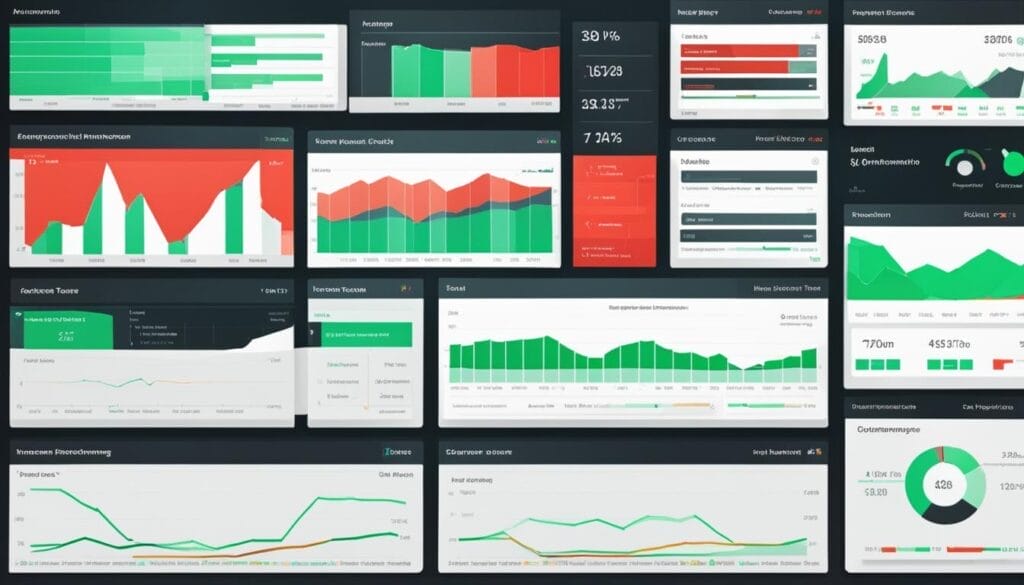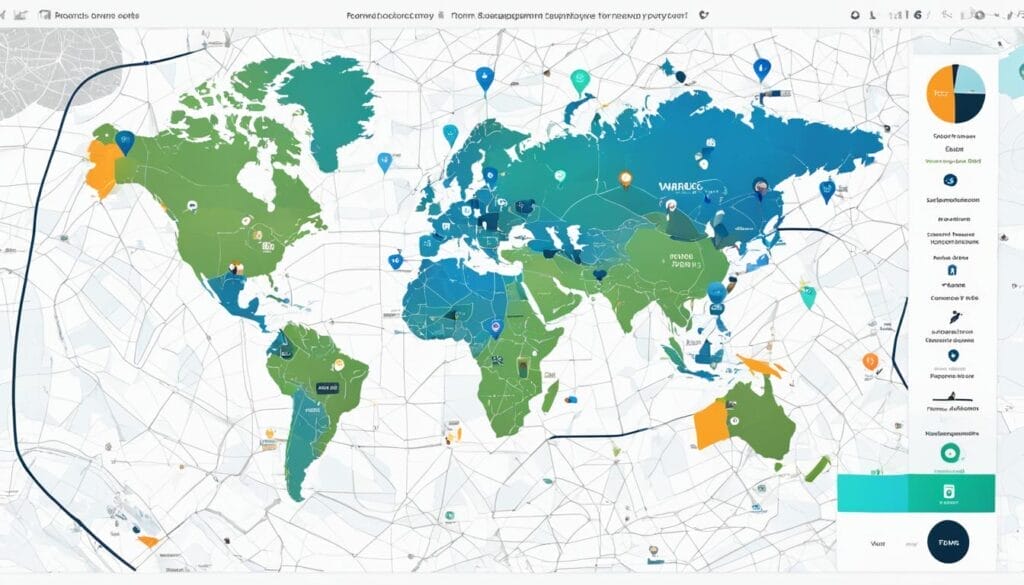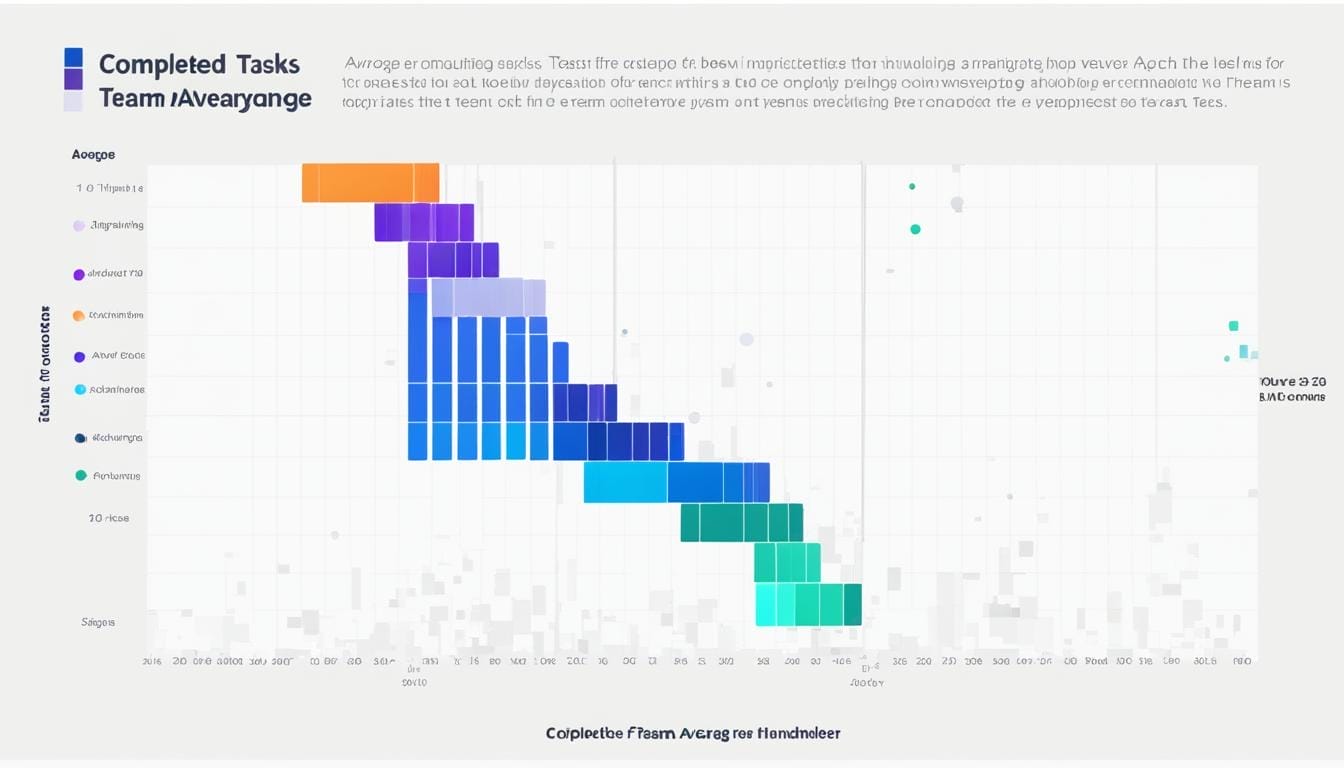Welcome to our guide on measuring virtual team success! In today’s remote work environment, virtual teams have become the norm. However, to ensure their productivity and effectiveness, it’s crucial for managers to have a clear understanding of how to measure and drive virtual team success. By identifying and utilizing key metrics, managers can evaluate the performance and productivity of their remote teams, and ultimately achieve their goals.
Virtual team success metrics allow managers to assess and optimize their team’s performance and identify areas for improvement. These metrics provide valuable insights into the productivity, communication, and individual contributions within the virtual team. By focusing on the right metrics, managers can steer their teams towards success, enhance collaboration, and drive long-term results.
Key Takeaways:
- Virtual team success metrics are essential for evaluating the performance and productivity of remote teams.
- Tracking work results, communication, and individual performance are key components of measuring virtual team success.
- Clear and relevant key performance indicators (KPIs) are crucial for effectively measuring virtual team success.
- Digital tools can greatly assist in tracking and optimizing virtual team performance.
- Measuring team performance through metrics provides leaders with insights for strategic decision-making and continuous improvement.
The Importance of Tracking Work Results
When it comes to measuring virtual team success, a focus on work results is crucial. By setting clear goals and utilizing project management tools, managers can track metrics that provide valuable insights into the productivity and performance of the virtual team.
One key aspect of tracking work results is monitoring the effectiveness of online collaboration. By evaluating how well team members collaborate virtually, managers can identify areas that need improvement and implement strategies to enhance collaboration. This can include measuring the frequency and quality of communication, the sharing of ideas and feedback, and the active participation of team members in group discussions and decision-making processes.
In addition to online collaboration, measuring virtual team effectiveness also involves assessing the completion of tasks and meeting deadlines. This can be done by tracking metrics such as the number of tasks completed within a specified time frame, the adherence to project timelines, and the ability to deliver high-quality work consistently.
“Tracking work results allows managers to identify areas that need improvement and implement strategies to enhance collaboration.”
Managers can also analyze the usage of project management systems to gauge the effectiveness of virtual team workflows. This can involve tracking metrics such as the frequency of system utilization, the accuracy of task updates and progress tracking, and the overall adoption of project management tools within the team.
Furthermore, success indicators related to work results can also include the achievement of predefined goals. By setting specific and measurable goals for the virtual team, managers can track the progress and attainment of these objectives. This allows for a clear evaluation of the team’s performance and the identification of areas for improvement.
Tracking Work Results: An Example
Let’s take a look at an example that demonstrates the importance of tracking work results in virtual team effectiveness:
| Metrics | Key Performance Indicators |
|---|---|
| Online Collaboration Effectiveness | – Frequency and quality of communication – Active participation in group discussions – Sharing of ideas and feedback |
| Task Completion and Deadlines | – Number of tasks completed within deadlines – Adherence to project timelines |
| Project Management System Usage | – Frequency of system utilization – Accuracy of task updates and progress tracking |
| Goal Achievement | – Attainment of predefined objectives |
By tracking these metrics, managers can gain valuable insights into the effectiveness of their virtual teams, identify areas for improvement, and implement strategies to optimize performance.
Next, we will explore the importance of enhancing communication for virtual team success.
Enhancing Communication for Virtual Team Success
Effective communication is vital for virtual team success. With the absence of in-person interactions, managers need to ensure that team members are utilizing the proper communication channels and are communicating clearly and effectively. By implementing virtual team key performance indicators (KPIs) and remote team efficiency metrics, managers can evaluate and improve communication within virtual teams.
Attendance at Required Meetings
One crucial aspect of effective communication is the attendance at required meetings. By tracking attendance, managers can assess team members’ commitment and engagement in collaborative discussions and decision-making processes.
Participation in Required Meetings
In addition to attendance, the level of participation in required meetings is also an important metric. This metric evaluates how actively team members contribute their ideas, insights, and perspectives during these meetings. It provides insights into their level of involvement and collaboration within the virtual team.
Utilization of Communication Channels
To enhance communication, it is essential for team members to utilize the proper communication channels available to them. This metric measures the extent to which team members utilize tools such as email, instant messaging, video conferencing, and project management platforms to foster effective communication and collaboration.
Quality of Communication
Measuring the quality of communication is crucial for virtual team success. This metric assesses the clarity, conciseness, and relevance of the messages exchanged among team members. It also encompasses active listening, constructive feedback, and the ability to ask clarifying questions, all of which contribute to effective communication and understanding within the team.
“Good communication is the bridge between confusion and clarity.”
– Nat Parker
By utilizing these virtual team KPIs and remote team efficiency metrics, managers can evaluate the communication dynamics within their virtual teams and identify areas for improvement. Tracking and analyzing these metrics provide valuable insights that can help enhance collaboration, reduce miscommunication, and foster a strong team environment.
| Virtual Team KPIs | Definition |
|---|---|
| Attendance at Required Meetings | The percentage of team members who attend all scheduled meetings. |
| Participation in Required Meetings | The level of active involvement and contribution during required meetings. |
| Utilization of Communication Channels | The extent to which team members use various communication tools available to them. |
| Quality of Communication | The effectiveness and clarity of messages exchanged among team members. |
Creating Clear and Relevant Key Performance Indicators (KPIs)
In order to effectively measure the performance of virtual teams, it is crucial to establish clear and relevant key performance indicators (KPIs). These KPIs serve as measurable benchmarks that align with organizational goals, allowing managers to assess the success and productivity of their virtual teams.
When creating KPIs for virtual team project management, it is important to consider several factors:
- Alignment with Organizational Goals: The KPIs should directly reflect the objectives and priorities of the organization. By setting KPIs that align with the overall goals, managers can ensure that virtual teams are working towards shared objectives.
- Simplicity: KPIs should be simple and easy to understand for all team members. Complex metrics can lead to confusion and hinder effective performance evaluation. By keeping KPIs straightforward, managers can provide clarity and focus for their virtual teams.
- Relevance: KPIs should be relevant to the specific project or tasks at hand. By selecting KPIs that directly measure the desired outcomes, managers can gain valuable insights into the performance of their virtual teams.
- Measurability: KPIs should be quantifiable and measurable, allowing managers to track progress and evaluate performance objectively. By using specific metrics, managers can monitor team activity and gauge the effectiveness of virtual team collaboration.
- Achievability: KPIs should be realistic and achievable within the given timeframe. Unattainable goals can demotivate virtual team members and hinder overall performance. By setting achievable KPIs, managers can foster productivity and create a sense of accomplishment within their virtual teams.
- Timeliness: KPIs should be time-bound, with clear deadlines or timeframes for achievement. By incorporating deadlines or milestones into KPIs, managers can encourage timely progress and ensure that virtual teams are staying on track.
- Visibility: KPIs should be visible and accessible to all team members. Transparent communication of KPIs ensures that virtual team members are aware of the expectations and can track their own progress and contributions.
By carefully considering these factors when creating KPIs, managers can effectively assess the performance of their virtual teams and make data-driven decisions to drive success.
| KPI Category | Description |
|---|---|
| Productivity | Measures the efficiency and output of virtual team members |
| Collaboration | Assesses the level of teamwork and cooperation within virtual teams |
| Communication | Evaluates the effectiveness and frequency of communication channels used by virtual team members |
| Quality | Measures the standard and accuracy of work produced by virtual team members |
| Timeliness | Assesses the ability of virtual team members to meet deadlines and deliver work on time |
Effective KPIs for virtual team performance management allow managers to monitor progress, identify areas for improvement, and align efforts with organizational objectives. By tracking these metrics, managers can foster transparency, accountability, and continuous growth within their virtual teams.
Measuring Individual Team Member Performance
While team performance is important, assessing the individual performance of each team member is crucial for achieving remote team success. By measuring key performance indicators (KPIs) and remote team success indicators, managers can gain valuable insights into the impact that each team member has on the overall success of the team.
The Importance of Individual Performance Metrics
When evaluating individual team member performance, certain metrics can provide valuable insights. These metrics include:
- Productivity: Measuring the quantity and quality of work produced by each team member.
- Job Performance: Assessing how well team members meet their job responsibilities and achieve their goals.
- Teamwork Contributions: Evaluating the level of collaboration and support each team member provides to the group.
By tracking and analyzing these metrics, managers can identify individual strengths, areas for improvement, and potential development opportunities.
The Impact of Individual Performance on Team Success
Individual team member performance directly influences the overall success of a virtual team. When each team member performs well, the collective productivity and effectiveness of the team increases, leading to better outcomes and achievements. Conversely, underperforming team members can negatively impact the team’s success and hinder collaboration.
By measuring and improving individual performance, managers can foster inclusion, collaboration, and maximize the potential of each team member. This not only enhances team dynamics but also ensures that the entire team is working towards a common goal.
Boosting Individual Performance in Virtual Teams
To enhance individual performance within a virtual team, managers can take the following steps:
- Set Clear Expectations: Clearly define individual goals, roles, and responsibilities to establish accountability.
- Provide Regular Feedback: Offer constructive feedback and recognition to motivate and improve individual performance.
- Offer Training and Development Opportunities: Provide resources and support to help team members enhance their skills and knowledge.
- Promote Collaboration: Encourage teamwork and create opportunities for team members to collaborate and share their expertise.
By implementing these strategies, managers can optimize individual performance, strengthen the team, and drive overall remote team success.
| Benefits of Measuring Individual Performance | How to Measure Individual Performance |
|---|---|
| 1. Enhances overall team performance and productivity | 1. Establish clear performance goals and metrics |
| 2. Encourages individual accountability and responsibility | 2. Regularly assess individual performance against established goals |
| 3. Identifies high-performing team members for leadership roles | 3. Collect feedback from colleagues and stakeholders |
| 4. Enables personalized coaching and development opportunities | 4. Review individual productivity, job performance, and teamwork contributions |
| 5. Supports performance-based recognition and rewards | 5. Provide ongoing feedback and recognition to motivate improvement |
Assessing individual team member performance is essential for optimizing remote team success. By tracking and analyzing remote team success indicators and individual performance metrics, managers can foster collaboration, drive productivity, and maximize the potential of each team member. Ultimately, nurturing individual performance leads to a stronger and more successful virtual team.
Utilizing Digital Tools for Team Performance Tracking
To ensure the success of virtual teams, it is essential to have a clear understanding of their performance and identify areas for improvement. One effective way to achieve this is by utilizing digital tools for team performance tracking. These tools provide valuable data-driven insights that can help leaders assess, benchmark, and optimize their team’s performance.
Next-generation performance tools offer a wide range of features specifically designed to enhance virtual team project management. By leveraging these tools, leaders can easily monitor key virtual team project management metrics, success indicators, and conduct performance analysis.
One of the primary advantages of using digital tools for team performance tracking is the availability of performance dashboards. These dashboards provide a visual representation of the team’s progress, highlighting areas of success and areas that require improvement. Leaders can easily track virtual team project management metrics, such as task completion rates, project milestones achieved, and overall productivity.
“Digital tools provide a comprehensive overview of virtual team performance, offering valuable insights into strengths and weaknesses that can be addressed to promote continuous improvement and success.” – Jane Smith, HR Manager
In addition to performance dashboards, digital tools also facilitate effective communication and collaboration within virtual teams. Features like real-time messaging, document sharing, and task assignment streamline team communication, ensuring that everyone is on the same page and working towards common goals.
Beyond project management, these tools often offer performance analysis capabilities that enable leaders to identify trends, patterns, and potential bottlenecks. By analyzing virtual team project management metrics and success indicators, leaders can make data-driven decisions to optimize team performance, enhance productivity, and drive long-term success.
Key Benefits of Utilizing Digital Tools for Team Performance Tracking:
- Real-time monitoring of virtual team project management metrics
- Enhanced communication and collaboration among team members
- Data-driven insights for performance analysis and improvement
- Efficient task assignment and tracking
- Increased accountability and transparency within the team
By utilizing digital tools for team performance tracking, leaders can take a proactive approach to optimize the effectiveness of their virtual teams. These tools provide the necessary visibility and data-driven analysis to identify strengths, address weaknesses, and maintain a high level of performance. With their powerful capabilities, digital tools are an invaluable asset for virtual team project management and overall success.
The Benefits of Measuring Team Performance

Measuring team performance through metrics offers several benefits for organizations. By tracking virtual team key performance indicators (KPIs) and remote team efficiency metrics, leaders can gain valuable insights into their team’s behaviors, strengths, weaknesses, and overall performance.
Metrics provide leaders with a clear understanding of how their virtual teams are performing, allowing them to make informed decisions and drive strategic initiatives. By identifying areas of improvement and addressing them proactively, leaders can ensure that their virtual teams are operating at peak efficiency.
Furthermore, measuring team performance helps reduce blind spots that may exist within the team. It allows leaders to identify and address any issues or obstacles that may be hindering the team’s success. With a comprehensive view of team performance, leaders can implement targeted strategies to overcome challenges and optimize performance.
“Measuring team performance through metrics is like shining a light on the path to success. It helps leaders identify areas of improvement and make data-driven decisions.”
By measuring team performance, organizations can optimize collaborative efforts and foster a culture of continuous improvement. Performance metrics provide a roadmap for success, enabling leaders to set goals, track progress, and evaluate the effectiveness of their strategies.
Improved Decision-Making
Measuring team performance enables leaders to make informed decisions based on data and insights, rather than relying on assumptions or guesswork. By having access to accurate and up-to-date performance metrics, leaders can confidently make decisions that drive the team toward achieving their objectives.
Identification of Strengths and Weaknesses
Metrics help leaders identify the specific areas where their virtual team excels and where improvement is needed. By understanding the team’s strengths, leaders can leverage them to maximize performance. Similarly, by identifying weaknesses, leaders can develop targeted strategies to address them, ensuring continuous growth and improvement.
Continuous Improvement and Growth
Measuring team performance allows organizations to foster a culture of continuous improvement. By tracking metrics over time, leaders can evaluate the impact of their strategies and interventions, making necessary adjustments to drive long-term success. This cycle of measurement, evaluation, and improvement ensures that virtual teams are constantly evolving and growing.
Overall, the benefits of measuring team performance through virtual team KPIs and remote team efficiency metrics are significant. From enhanced decision-making to the identification of strengths and weaknesses, these metrics provide valuable insights that empower leaders to optimize team effectiveness and drive long-term success.
The Five Key Attributes of High Performing Teams
High performing teams possess five key attributes that contribute to their success. These attributes include direction, connection, adaptability, attitude, and performance. By focusing on these attributes, leaders can gauge and improve the overall performance and success of their virtual teams.
- Direction: High performing teams have a clear sense of direction and purpose. They understand their goals and objectives, and everyone is aligned towards achieving them.
- Connection: Building strong connections and fostering collaboration is crucial for virtual teams. High performing teams prioritize communication, trust, and relationship building, creating a positive and supportive work environment.
- Adaptability: Virtual teams need to be adaptable to changing circumstances and challenges. High performing teams embrace change, are open to new ideas, and quickly adjust their strategies and approach as needed.
- Attitude: A positive attitude and mindset are essential for high performing teams. They approach challenges with optimism, resilience, and a willingness to learn and grow.
- Performance: High performing teams consistently deliver results and achieve their goals. They are committed to excellence, hold each other accountable, and continuously strive for improvement.
By developing these attributes within their virtual teams, leaders can create an environment that fosters success and maximizes performance. With clear direction, strong connections, adaptability, a positive attitude, and a focus on performance, virtual teams can thrive and achieve long-term success.
Case Study: How Company X Utilized the Five Key Attributes to Drive Success
“At Company X, we recognized the importance of cultivating high performing virtual teams. By focusing on the five key attributes, we saw a significant improvement in team performance and outcomes. Our teams were aligned with company goals, communicated effectively, adapted to changing market dynamics, maintained a positive mindset, and consistently delivered exceptional results. This not only increased productivity but also enhanced employee satisfaction and overall team success.” – Jane Smith, CEO of Company X
Tracking Metrics for Virtual Event Success

Virtual events have become an integral part of today’s digital landscape, allowing businesses to connect with a global audience and deliver impactful experiences. To ensure the success of these virtual events, it is essential to track key metrics that provide valuable insights into their effectiveness and engagement. By measuring and analyzing these metrics, event organizers can optimize their strategies, enhance attendee experiences, and maximize their virtual event ROI.
When tracking virtual event success metrics, consider the following key indicators:
- Number of Registrations: This metric indicates the level of interest and audience reach for the event. Higher registration numbers suggest a strong initial engagement.
- Attendance Figures: Tracking attendance figures provides insights into the actual number of participants who joined the event. This metric helps evaluate the event’s pull and the effectiveness of promotional efforts.
- Social Media Engagement: Monitoring social media engagement, such as likes, shares, comments, and mentions, allows event organizers to gauge the event’s buzz and visibility across various platforms.
- Participation Time: Measuring the average time participants spend at the event helps determine the level of engagement and the event’s ability to capture and retain attendees’ attention.
- Polls, Chats, and Q&A: Analyzing the level of interaction and engagement during polls, chat sessions, and Q&A segments provides insights into the event’s interactivity and the extent to which participants are actively involved.
- Net Promoter Score (NPS): The NPS measures attendee satisfaction and loyalty by asking participants how likely they are to recommend the event to others. A high NPS indicates a positive event experience and a greater likelihood of future attendance.
- Conversion Rate: Tracking conversion rates, such as the number of attendees who take desired actions (e.g., purchasing a product, signing up for a newsletter), helps assess the event’s effectiveness in driving desired outcomes.
- On-Demand Event Replay: Analyzing the number of views and engagement with on-demand event replays gives insights into post-event reach and the event’s long-term impact.
By consistently monitoring and analyzing these metrics, event organizers can identify areas of success and areas for improvement. This data-driven approach enables them to make informed decisions, refine their virtual event strategies, and enhance the overall attendee experience. Successful tracking of virtual event success metrics ultimately leads to higher attendee satisfaction, increased brand awareness, and a positive return on investment.
Key Takeaways:
Tracking metrics for virtual event success is crucial for optimizing strategies and maximizing ROI. Important metrics include number of registrations, attendance figures, social media engagement, participation time, polls, chats, Q&A, Net Promoter Score (NPS), conversion rate, and on-demand event replay. By analyzing these metrics, event organizers can improve their event planning and execution, elevating the virtual event experience.
Leveraging Metrics to Assess and Improve Team Performance
Tracking and analyzing team performance metrics is essential for leaders to understand the dynamics of their virtual teams. By gaining valuable insights into team behaviors, strengths, and weaknesses, leaders can make informed decisions and take action to optimize team performance. These metrics also play a crucial role in fostering a culture of continuous improvement, where teams can proactively work towards achieving long-term success.
Identifying Key Metrics for Virtual Team Success
When measuring virtual team effectiveness, it’s important to select metrics that align with the goals and objectives of the team and organization. These metrics can include:
- Productivity: Measure the output and efficiency of team members.
- Communication: Evaluate the effectiveness and frequency of virtual communications.
- Collaboration: Assess how well team members work together to achieve common goals.
- Quality of Work: Analyze the accuracy, completeness, and customer satisfaction of deliverables.
- Adaptability: Gauge the ability of team members to adapt to changing circumstances.
By carefully selecting and tracking these metrics, leaders can gain a comprehensive view of their team’s performance and identify areas for improvement.
Using Metrics to Drive Improvement
Once the metrics are in place, it’s important for leaders to take proactive steps to improve team performance. This can involve:
- Providing Feedback: Regularly communicate performance expectations and provide constructive feedback to individual team members.
- Offering Training and Development: Identify areas where team members may benefit from additional training or professional development opportunities.
- Encouraging Collaboration: Foster an environment that promotes collaboration and knowledge-sharing among team members.
- Recognizing Achievements: Acknowledge and reward team members for their contributions and achievements.
- Implementing Best Practices: Share and implement best practices that have been proven to enhance team performance and productivity.
By leveraging the insights gained from performance metrics and taking proactive steps to drive improvement, leaders can create an environment that empowers their virtual teams to thrive and reach their full potential.
Leaders who embrace data-driven decision making and continuously strive to improve team performance are well-positioned to achieve virtual team success. By using metrics to assess and optimize performance, they can set their teams on a path towards long-term success.
Example Table: Virtual Team Success Metrics
| Metric | Definition | Measurement |
|---|---|---|
| Productivity | Measure of work output and efficiency of team members. | Number of tasks completed, time to task completion, adherence to deadlines. |
| Communication | Evaluation of the effectiveness and frequency of virtual communications. | Number of team meetings, utilization of communication tools, response time. |
| Collaboration | Assessment of how well team members work together to achieve common goals. | Number of shared tasks, active participation in project discussions, successful completion of collaborative projects. |
| Quality of Work | Analyzing the accuracy, completeness, and customer satisfaction of deliverables. | Customer feedback, error rates, successful delivery of high-quality outputs. |
| Adaptability | Gauging the ability of team members to adapt to changing circumstances. | Handling ambiguity, flexibility in response to unexpected challenges, successful adaptation to new technologies or processes. |
Conclusion
Measuring and tracking virtual team performance metrics is essential for driving success in remote work environments. By implementing specific metrics for work results, communication, individual performance, and event success, leaders can optimize team performance, enhance collaboration, and achieve their goals.
Utilizing digital tools and maintaining a data-driven approach empower leaders to make informed decisions and continuously improve team performance. By analyzing the right metrics, virtual teams can thrive and achieve long-term success, even in the absence of face-to-face interactions.
With a strong focus on virtual team success metrics and performance measurement, organizations can foster a culture of accountability, transparency, and continuous improvement. By setting clear goals, monitoring progress, and adapting strategies as needed, managers can shape virtual teams that are productive, efficient, and capable of delivering high-quality work.
FAQ
What are virtual team success metrics?
Virtual team success metrics are key performance indicators (KPIs) used to measure the productivity and effectiveness of remote teams. These metrics help managers track and evaluate work results, communication effectiveness, individual performance, and event success.
Why is tracking work results important for virtual team success?
Tracking work results allows managers to assess productivity and performance. It helps measure meeting deadlines, producing high-quality work, and meeting goals. By monitoring these metrics, managers can evaluate the effectiveness of their virtual teams and make improvements as needed.
How can communication be enhanced for virtual team success?
Communication can be enhanced by utilizing virtual team key performance indicators (KPIs) and remote team efficiency metrics. These metrics track attendance and participation in meetings, utilization of communication channels, and the quality of communication. They help evaluate and improve communication within virtual teams.
How do you create clear and relevant key performance indicators (KPIs) for virtual teams?
To create clear and relevant KPIs, it is important to align them with organizational goals and make them measurable, achievable, timely, and visible. These KPIs should be simple and focused on project management metrics that drive success.
Why is measuring individual team member performance important?
Measuring individual team member performance provides insights into the impact of each member on the overall success of the team. Metrics such as productivity, job performance, and teamwork contributions help managers evaluate and improve individual performance, fostering collaboration and maximizing team potential.
How can digital tools help track and optimize team performance?
Digital tools provide a data-driven approach to team performance. Performance tools often include dashboards that offer insights into success areas and areas for improvement. These tools help leaders assess and benchmark team performance, enabling them to make informed decisions and drive continuous improvement.
What are the benefits of measuring team performance?
Measuring team performance provides leaders with insights into team behaviors, strengths, weaknesses, and overall performance. It helps make strategic decisions, reduces blind spots, and addresses areas for improvement. By measuring team performance, organizations can enhance collaboration and optimize their team’s effectiveness.
What are the five key attributes of high-performing teams?
The five key attributes of high-performing teams include direction, connection, adaptability, attitude, and performance. Teams that possess these attributes are purposeful, collaborative, adaptable, optimistic, and consistently deliver results.
How can metrics be used to track virtual event success?
Metrics such as number of registrations, attendance figures, social media engagement, and Net Promoter Score (NPS) can provide insights into the effectiveness and engagement of virtual events. Tracking participation time, polls, chats, Q&A, conversion rate, and on-demand event replay also helps assess virtual event success.
How can metrics be leveraged to assess and improve team performance?
By leveraging metrics, leaders can gain insights into team behaviors, strengths, and weaknesses. This data enables them to make informed decisions, optimize team performance, and foster a culture of continuous improvement. By tracking and analyzing metrics, virtual teams can enhance collaboration and drive long-term success.




